Search
Search Results
-
Automatic identification of self-admitted technical debt from four different sources
Technical debt refers to taking shortcuts to achieve short-term goals while sacrificing the long-term maintainability and evolvability of software...

-
Identifying Self-admitted Technical Debt with Context-Based Ladder Network
Technical debt occurs when development teams take actions to expedite the delivery of a project at the cost of poor code quality and additional work...
-
A two-stage approach for identifying and interpreting self-admitted technical debt
A major current focus in software quality is how to identify and interpret Self-admitted technical debt(SATD). While many methods have been proposed...

-
Quantifying and characterizing clones of self-admitted technical debt in build systems
Self-Admitted Technical Debt (SATD) annotates development decisions that intentionally exchange long-term software artifact quality for short-term...

-
Keyword-labeled self-admitted technical debt and static code analysis have significant relationship but limited overlap
Technical debt presents sub-optimal choices made in development, which are beneficial in the short term but not in the long run. Consciously admitted...

-
On the documentation of self-admitted technical debt in issues
Self-Admitted Technical Debt ( Satd ) is a particular case of Technical Debt ( TD ) in which developers rely on source code comments ( Satd-C ) or labeled...

-
An Empirical Study on the Urgent Self-admitted Technical Debt
Technical Debt (TD) refers to the phenomenon of taking shortcuts to achieve short-term gains at the cost of higher maintenance effort in the future....
-
Identifying self-admitted technical debt in issue tracking systems using machine learning
Technical debt is a metaphor indicating sub-optimal solutions implemented for short-term benefits by sacrificing the long-term maintainability and...

-
FIXME: synchronize with database! An empirical study of data access self-admitted technical debt
Developers sometimes choose design and implementation shortcuts due to the pressure from tight release schedules. However, shortcuts introduce...

-
Self-admitted technical debt in R: detection and causes
Self-Admitted Technical Debt (SATD) is primarily studied in Object-Oriented (OO) languages and traditionally commercial software. However, scientific...

-
Self-Admitted Technical Debt and comments’ polarity: an empirical study
Self-Admitted Technical Debt (SATD) consists of annotations—typically, but not only, source code comments—pointing out incomplete features,...

-
An empirical study on self-admitted technical debt in Dockerfiles
In software development, ad hoc solutions that are intentionally implemented by developers are called self-admitted technical debt (SATD). Because...

-
Toward prioritization of self-admitted technical debt: an approach to support decision to payment
Technical Debt (TD) is a metaphor that describes the cost–benefit relationship between postponing technical development activities and the...

-
Using BiLSTM with attention mechanism to automatically detect self-admitted technical debt
Technical debt is a metaphor for seeking short-term gains at expense of long-term code quality. Previous studies have shown that self-admitted...
-
Self-admitted technical debt practices: a comparison between industry and open-source
Self-admitted technical debt (SATD) consists of annotations, left by developers as comments in the source code or elsewhere, as a reminder about...

-
A framework for conditional statement technical debt identification and description
Technical Debt occurs when development teams favour short-term operability over long-term stability. Since this places software maintainability at...

-
DebtFree: minimizing labeling cost in self-admitted technical debt identification using semi-supervised learning
Kee** track of and managing Self-Admitted Technical Debts (SATDs) is important for maintaining a healthy software project. Current active-learning...

-
Utilization of Machine Learning for the Detection of Self-admitted Vulnerabilities
Motivation: Technical debt is a metaphor that describes not-quite-right code introduced for short-term needs. Developers are aware of it and admit it...
-
Forecasting technical debt evolution in software systems: an empirical study
Technical debt is considered detrimental to the long-term success of software development, but despite the numerous studies in the literature, there...
-
Wait for it: identifying “On-Hold” self-admitted technical debt
Self-admitted technical debt refers to situations where a software developer knows that their current implementation is not optimal and indicates...

